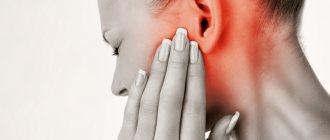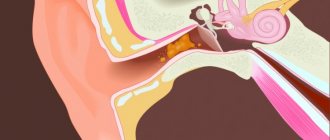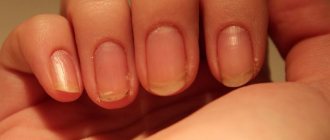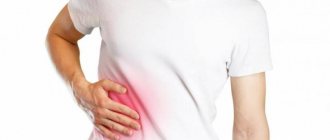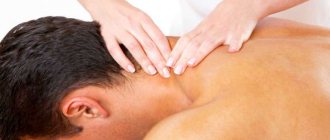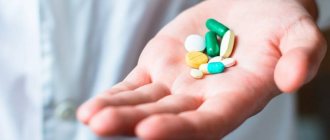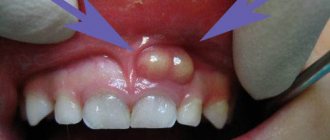Only a qualified specialist can unequivocally answer the question of why a particular person’s heart is stabbing. Finding the cause of discomfort on your own is quite difficult. It is necessary to rely not only on the localization of the stabbing pain, but also on the circumstances under which it appears. It is also necessary to take into account the patient's age and associated symptoms.
Stitching pain in the heart can occur in adults and children
Causes
Many reasons have been identified that cause sharp stabbing pain in the heart area; the most dangerous are those that contribute to the development of a long-term and severe symptom, since they indicate serious health problems. The most commonly diagnosed diseases are:
- Myocarditis is an inflammatory process that occurs in the heart. It develops in the presence of infectious diseases in the body, taking certain medications, or with a sharp decrease in immunity. It is characterized by the fact that acute stabbing pain persists for a long time, shortness of breath occurs and body temperature increases. The occurrence of pain does not depend on the effects of physical activity.
- Intercostal neuralgia is common. It is distinguished by the presence of inflammatory reactions in the plexus and nerve fibers. The pain symptom is aching or acute. The main disease in such cases is osteochondrosis, which causes stabbing pain in the heart.
- Vegetovascular dystonia is the presence of disorders of the autonomic nervous system, which is responsible for the functioning of internal organs. Vegetative-vascular dystonia often occurs after prolonged depression. A similar reason is determined by the occurrence of a symptom when the patient is completely at rest; the latter complains of a rapid heartbeat and a concomitant increase in blood pressure.
- Pericarditis is an inflammatory process that affects the outer lining of the heart. In such situations, pain can occur in the early stages of the pathology and is considered the primary symptom that indicates the formation of pericarditis.
- Neurosis is a pathology of the nervous system that indicates severe stress and mental trauma experienced. Patients complain of frequent headaches, constant malaise and fatigue.
It is possible that more rare causes may develop that contribute to the development of pain:
- Aortic dissection or rupture occurs due to the fact that blood, through violations of the integrity of the internal layers of blood vessels, is able to further destroy the middle and outer layers of the aorta. In such cases, the heart pain is powerful and can change location as further vascular stratification occurs.
- Thrombus formation is the formation of a blood clot that disrupts blood circulation in the vessels and causes a heart attack. The symptoms are the same as pericarditis, but a heart attack is more serious and dangerous.
- Angina pectoris is a common form of ischemia, which is determined by the occurrence of sharp pain in the middle of the chest (sometimes slightly lower) with accompanying shortness of breath. Occurs due to spasm of the coronary vessels. Another common name for the disease is angina pectoris.
- Embolism – a similar pathology develops when there is insufficient oxygen supply to the heart muscle. This most often occurs when there is a blood clot in the pulmonary artery that is preventing normal blood flow. This pathology is manifested by periodic slight tingling in the chest area, often observed with deep breaths.
- Diseases of the stomach and intestines - a symptom manifests itself in the presence of diseases such as gastritis, ulcers, cholecystitis. Patients complain of aching discomfort in the middle of the chest area.
- Colds - the occurrence of an unpleasant symptom manifests itself as the body’s reaction to toxins. Patients often say that their heart is squeezing.
- Congenital heart defects are a serious pathology in which sharp stabbing pains in the heart indicate a disease and require medical supervision.
- Regular physical activity - with increased functioning of the body, discomfort often appears in the left side of the chest. The symptom disappears after stopping the load, during rest.
- The presence of severe stress or regular worries - sedatives help in the fight against unpleasant sensations.
- Various rib injuries - bruises or fractures. The pain syndrome is accompanied by difficulty breathing. Patients may feel as if their heart is hurting. With adequate medical therapy, the pain disappears irrevocably.
There are many reasons that cause a painful symptom, some of them are dangerous, so if such symptoms occur, you need to seek help from a doctor to find out the underlying disease and receive treatment, it is prescribed individually for each patient.
Respiratory diseases
Pain when breathing in the heart area accompanies pulmonary pathologies in all forms. The cause is a painful pleura. Pain receptors from it transmit impulses to the intercostal nerves. Painful sensations are localized in a certain part of the chest.
Discomfort can be caused by inflammation of the bronchi - the fibers of their nerves and trachea are located in the area of the vagus nerve.
Small vessels and the lining of the lungs give pain only when inflammation or neoplasms touch the pleura and affect the large bronchi. The greatest pain is achieved when the lungs are destroyed.
- pneumonia;
- abscess;
- neoplasms;
- pleurisy.
In bronchopulmonary pathologies, pain is accompanied by wheezing and pleural friction.
Pneumonia has the following symptoms:
- shortness of breath of varying severity;
- high temperature 39.5 degrees Celsius;
- rave;
- high breathing and heart rate;
- cyanosis;
When over 60 years of age and complicated by other diseases, a particularly serious condition is observed.
The cause of pain when breathing can be inflammation of the membrane lining of the chest cavity, pleurisy. The reason leading to inflammation is:
- pneumonia;
- chest injuries;
- neoplasms of various nature.
- primary, caused by pleural rupture;
- secondary, caused by pneumonia.
Symptoms:
- pain is worse when breathing;
- discomfort is less when a person lies on the sore side;
- shallow breathing due to fear of pain;
- weakness, sweat and chills at night;
- The noise of the pleura differs when listening.
When the pleura is affected, the painful sensations are described by patients as stabbing, activated by coughing and breathing - the same as with myositis and injuries to the intercostal muscles.
Pneumothorax causes severe pain.
Severe pain in the heart area when inhaling is observed in the first stages of bronchogenic lung cancer. When cancer develops at the apex of the lung, the pain quickly affects the nerves of the brachial plexus and radiates strongly into the arm. The patient has a narrowing of the pupil on the side of the tumor localization.
What to do if your heart hurts
If you feel sick in the area of the heart, then you need to consult a doctor - a therapist, a neurologist, or a cardiologist who can determine the cause and prescribe treatment.
If your heart hurts for the first time, and the cause is unknown, then it is better to first go to a therapist. If there is a piercing stabbing in the area of the heart periodically and the cause is known, then follow the doctor’s instructions or repeat the appointment at the clinic. If the cause is unknown, and the attack occurred for the first time, then contact a therapist, who will either prescribe treatment or refer you to a specialized specialist.
Urgent Care
We must not forget that self-prescription of treatment is unacceptable, since dangerous pathologies may be hidden behind such symptoms. Sudden and piercing pain in the heart area can be relieved with painkillers, but you should not postpone a visit to the doctor. If the condition does not improve, call an ambulance.
To provide first aid, you need to know what to do if your heart hurts:
- Ensure complete rest and give a comfortable lying position.
- Provide fresh air, open a window and free your neck from tight clothing. However, going outside and walking is not recommended.
- If the pain is acute, then use painkillers. Analgin, Ibuprofen, Ketanov, Nimesil, Paracetamol and others are good for this.
- If cardiac pathology is diagnosed, then resort to the help of Validol, Corvalol, Barvalol and other means.
- Vegetative-vascular dystonia or stressful conditions - it is necessary to take valerian, Persen.
Important! It is not recommended to take Nitroglycerin when pain in the heart area is observed as a simple tingling and there is no feeling of constriction in the heart, as this will aggravate the situation.
What to do if your heart hurts sometimes?
If you can use palpation to determine the location of the pain, then the heart has nothing to do with it. In such cases, it is necessary to rest and do a tonic massage (for complete disappearance of symptoms, do this every day for two weeks to a month). If the pain is severe, consult a doctor for proper diagnosis and treatment.
The following methods are prescribed for diagnosis:
- Echocardiography (echocardiography) – makes it possible to determine the condition of the valves and heart.
- ECG (electrocardiogram) - performed at rest and in the presence of a certain load; 24-hour monitoring is often prescribed.
- Ultrasound (ultrasound diagnostics) – the speed of blood movement is determined.
- Phonocardiogram - to listen for the presence of heart murmurs.
- Coronography – determines the condition of the coronary vessels.
lechiserdce.ru
What examinations need to be completed
Approximate diagnostic tactics are determined by a cardiologist. The initial appointment and routine methods are carried out by a therapist. Among the ways to identify the etiology of the process and make a diagnosis:
- Oral questioning of the patient regarding complaints. Already at this stage you can roughly understand what doctors are dealing with.
- Anamnesis collection. Family history, previous diseases, current somatic and other pathologies, treatment, if any, its duration, specific names of drugs. The vector of further examination is determined by these two methods.
- Listening to heart sounds. With cardiac problems, changes will always occur. Their absence is grounds for revising the probable diagnosis, although there are complex clinical cases.
- Measurement of blood pressure and heart rate.
- For the purpose of dynamic assessment, 24-hour monitoring is used using an automatic Holter programmable tonometer.
- Electrocardiography. Functional impairment, even minimal, will be noticeable. The main problem is the need for highly qualified diagnosticians and cardiologists.
- Echocardiography. Ultrasound technique. All organic disorders are visually determined.
- MRI or CT. If neoplastic or other pathologies are suspected.
- Angiography.
As necessary, under the supervision of other specialists, the following studies are prescribed: FGDS, ultrasound of the abdominal cavity, general blood test, biochemistry, etc. The list is incomplete. The issue is resolved on the spot.
Heart diseases that can cause this defect
- Neurosis of the heart.
Anomalies in the activity of regulatory systems in the brain can provoke stabbing pain in the heart area. The main reasons why this problem arises: overwork, a large number of nervous experiences, depressive moods.
Most often, people of an overly emotional nature who react sharply to any events are prone to it. In a stressful situation, an excess amount of adrenaline is produced, which is not used. Because of this, my heart hurts.
- Heart attack.
When a sharp stabbing pain appears in the left side of the chest, worsening when inhaling, this may be a sign of a heart attack. A blood clot forms in one of the arteries, which interferes with the movement of blood through the vessels. This is what causes pain.
This disease is very dangerous; it threatens health and life. The formation of this deviation needs to be identified in a timely manner, since only this will allow the patient to be cured.
- Spasm.
Coronary spasm is diagnosed when the movement of blood through the vessels decreases. Because of this, a stabbing pain appears in the heart, which becomes stronger when inhaling. A break in the blood supply provokes the destruction of heart cells, which causes this symptom.
- Pericarditis.
With this pathology, fluid accumulates in the pericardial sac, or an inflammatory process develops in its tissues. Therefore, tingling in the heart area may occur.
- Angina pectoris.
If a patient has angina, this means the formation of fat cells in the blood vessels, which complicates the flow of blood. Less blood and the substances it needs flows to the heart, which causes discomfort on the left side of the chest.
- Aortic dissection.
A rupture of this artery causes blood to leak out of its walls. This causes even more delaminations. When all three layers of the aorta rupture, it causes severe blood loss. In this case, the pain in the left chest can be not only stabbing, but also cutting.
- Cardiomyopathy.
The basis of this disease is ventricular hypertrophy. This pathology provokes stabbing pain in the heart area.
Traditional methods of treatment
For stabbing pain in the heart, you can use folk recipes to alleviate the condition. However, you need to remember that they only relieve symptoms, but do not eliminate the cause.
Such recipes can be used as the main medicine only in mild cases when the problem is caused by stress or vegetative dystonia. If pain is a consequence of ischemia or other serious cardiac pathologies, then there will be no effect from treatment with folk remedies. In this case, they need to be combined with drug therapy. The following recipes are most effective:
- A mixture of hawthorn and valerian. An infusion of them should be mixed and drunk in an amount of 0.5 tbsp. l. You can take the medicine not in its pure form, but dilute it with 1/3 glass of water. For faster absorption, the infusion can be held in the mouth before swallowing.
- Rose hip decoction. To prepare, grind the root of this plant and mix 1 tbsp. l. the resulting powder with 250 ml of water. Next, you need to boil the decoction for about 15 minutes and drink 3 glasses a day instead of tea.
- Fir oil. It is rubbed with massaging movements into the chest next to the left nipple. Relief is felt approximately 5 minutes after the start of the procedure.
- Melissa infusion. Dried and ground leaves of the plant in the amount of 2 tbsp. l. pour into a container with 300 ml of boiling water. You need to drink lemon balm infusion 0.5 cups daily.
- Walnut infusion. To prepare, you will need to chop 30 nut kernels and then pour them into a container with 1 liter of alcohol. The infusion will have to be infused for 2 weeks under sunlight. Before use, the medicine should be strained. You need to drink it 1 tbsp. l. within 30 days.
If you are worried about tingling in the heart, then you need to find out the cause of this phenomenon. Basically, the problem lies in stress or back disease, but sometimes such a symptom indicates the beginning of the development of severe cardiac pathology.
An experienced doctor must diagnose the disease using instrumental examination methods. The patient can only determine the nature of the pain and slightly alleviate his condition at home before the ambulance arrives or an independent visit to the hospital.
cardiograf.com
Causes of stabbing pain not related to heart disease
Sometimes pain in the heart area occurs in the absence of diseases of this organ. Why then does the heart hurt? This symptom can be provoked by pathologies in the functioning of other organs. This:
- Allergy.
Allergic reactions occur for various reasons, and the ways in which they manifest themselves are equally diverse. One such way is chest pain that gets worse when you inhale.
Heartburn.
Stitching pain may occur due to the gastric juice produced in this case.
- Panic.
If a person is prone to strong emotions and anxiety, he may develop heart problems. Overload arising from excessive emotions can cause pathologies in the activity of the heart.
- Neuralgia.
Fatigue, constant disruptions to the daily routine, and frequent emotional stress can harm the human body as a whole and each organ individually.
This symptom can occur for various reasons, so you should not think about heart pathologies and draw conclusions before the examination is carried out.
If you start taking the wrong medications, it can be harmful.
Approximate treatment tactics
The complaint of colitis in the heart area is not very informative. Diagnostics shows the process itself, it is possible to determine its etiology.
Therapy directly depends on the nature of the phenomenon, its duration, and neglect. Both medications and surgical solutions are used.
You can answer as follows:
- Gastric problems are corrected by taking proton pump inhibitors and antacids. Diet and proper nutrition play the biggest role. It is better to discuss the issue with a gastroenterologist.
- Osteochondrosis cannot be treated as such; it can be put into remission. For this purpose, anti-inflammatory drugs of non-steroidal and steroidal origin are used. After the acute period is over, massage and physiotherapy are indicated. Hernias are eliminated surgically, but only beyond the possibility of conservative care.
- Cardiac processes themselves are treated through a group of medications, depending on the nature of the phenomenon. From glycosides to ACE inhibitors, antiarrhythmic drugs. Surgical therapy is possible, but this is a last resort.
When selecting a course and, in general, ways to correct the condition, the principle of expediency is observed. There is no need to treat gastritis through gastrectomy, this is an exaggerated example, but this is how it is in practice.
First aid
People want to know what to do to overcome this symptom. If stabbing pain appears in the heart muscle, the patient first needs to calm down. When the cause of a painful symptom is excessive physical activity, the person should simply rest.
This will help him get rid of unpleasant feelings. The strong emotions that caused this problem must also be overcome. The best way to do this is rest and relaxation. Sometimes this is difficult to do, and you need to use light sedatives or brew a medicinal mixture.
But if the pain from the measures taken does not go away and intensifies when you inhale, you need to seek help from a doctor. They will do tests to make sure there are no heart problems. But often severe pain indicates the presence of pathologies that had not previously manifested themselves.
What to do at home?
If mild stabbing pain occurs, it is recommended to drink a glass of warm water with sugar. You can also use soothing tinctures if unpleasant sensations arise due to emotional stress. In such situations, decoctions of chamomile, valerian root, and oregano help well. Medicinal herbs are sold in every pharmacy and are inexpensive (up to 100 rubles).
First aid
First aid is required if severe pain, dizziness, or speech impairment occurs. Stitching pain most often appears during an attack of cardiac neurosis. To eliminate it, you need to sit in a deep, comfortable chair and drink 30 drops of Corvalol. Before going to bed, you should take a mild sleeping pill. The patient should not drink alcohol or smoke.
To get rid of pain you need to take 30 drops of Corvalol
What to do if the patient loses consciousness? It is necessary to remove constrictive clothing and accessories from the person. You can do an indirect cardiac massage. The patient should not be shifted or disturbed. If the air in the room is stale, then you need to open the window.
Diagnostic features
When a person often has colitis in the heart, he should consult a cardiologist. The doctor will be able to carry out diagnostic procedures and choose the most effective treatment method. You cannot do this on your own, because this requires the appropriate knowledge.
The main diagnostic methods in this case are:
- ECG.
- Echocardiography.
- X-ray.
- Holter monitoring.
- Blood chemistry.
Clinics where diagnostics can be performed:
If a person often experiences stabbing pain in the chest that gets worse when inhaling, this does not necessarily mean there is a heart problem.
This symptom may be caused by diseases of other organs or fatigue.
Therefore, you need to see a doctor who will diagnose and choose treatment. You cannot do this on your own.
dlyaserdca.ru
Extracardiac factors
Much more diverse.
Diaphragmatic hernia
Protrusion of anatomical structures into the lumen of the abdominal cavity. Occurs at any age, usually against the background of intense physical activity, overeating, and anatomical abnormalities during fetal development.
A relatively common phenomenon, it occurs in every thousand people on the planet. Almost does not make itself known, until a certain moment.
Chest pain is weak, aching, stabbing. Discomfort increases when eating or mechanical activity.
Inflammation of the pleura
This is the membrane lining the lungs. Rarely acts as an isolated process. More often accompanied by pneumonia or, at a minimum, bronchitis.
The complex phenomenon requires urgent medical care under the supervision of a pulmonologist. If your heart hurts (presumably), you need to take a couple of deep breaths.
Problems with the pulmonary system will reveal themselves at one point. Against the background of movements, discomfort increases significantly, which does not happen with pathologies of cardiac structures. This method can be used independently to determine the cause early.
Intercostal neuralgia
One of the most common factors of pain syndrome. With intercostal neuralgia, it always seems that the heart is pounding when inhaling.
Discomfort is localized in the chest. In fact, special nerve fibers and muscle structures become inflamed.
Pathology can only be delimited objectively, based on the results of ECG, ECHO and other techniques. You can suspect something is wrong by again taking a deep breath. The pain will intensify. This does not happen with cardiac pathologies.
Fractures, bruises of ribs, cracks
They arise against the background of certain phenomena, the connection with which the patient can trace himself. Again, heart damage is also possible. Diagnostic measures put an end to the issue.
Osteochondrosis of the thoracic spine
Inflammatory, degenerative diseases of the musculoskeletal system. It is extremely difficult to distinguish it from cardiac pathologies.
Radiography is used as the main method of verification and differential diagnosis.
Stomach problems
Like gastritis, ulcers of the mucous membrane. The tingling sensation becomes stronger when eating food, taking anti-inflammatory medications, and others.
Causes of heart pain
The causes of pain are different.
They can be cardiac or non-cardiac:
- Heart reasons.
- A sharp stabbing pain with burning occurs during myocardial infarction. It is provoked by a blood clot that blocks the proper functioning of the heart and deprives the organ of nutrients and oxygen, promoting tissue necrosis. The pain is pronounced, radiating to the neck, jaw, limbs, shoulder blades, and is associated with pale skin, nausea, gag reflex, anxiety and restlessness. The patient breaks out in a cold sweat and has difficulty breathing.
- The coronary arteries are responsible for the blood supply and delivery of nutrients and oxygen to the myocardium. When coronary vessels spasm, blood flow may be interrupted and necrosis of heart cells will occur. The cause of spasm in most situations is ischemia . During this period, stabbing pains to the left of the chest, characteristic of an attack, may appear.
- Short-term stabbing pain near the heart appears during angina . This is caused by blockage of blood vessels by fatty plaques formed on the vascular walls. Painful sensations occur in a calm state or during physical activity. To relieve tension, you need to take a comfortable position, relax and lie down for a certain period of time.
- Stitching pain can be a harbinger of inflammatory processes in the serous membrane of the heart. The causes of this condition can be caused by bacterial, viral or fungal infections, allergies, overdose or chaotic use of medications for heart diseases. Acute stabbing pain is sometimes caused by aortic rupture.
- Non-cardiac causes:
- Heartburn is a condition that is extremely unpleasant for a person, since there is a burning sensation inside, and in combination pain sensations can be traced in the left side or near the heart. It can be caused by reflux. At the same time, discomfort near the sternum continues for quite a long time.
- Pleurisy and pneumonia are inflammatory processes in the lungs. Pain near the heart may appear during inhalation or coughing. A pulmonary embolism is a stoppage of the blood supply to the heart due to a blood clot entering the pulmonary artery. One of the signs of such a failure will be a sharp, stabbing pain near the heart. The main symptom will intensify during coughing. The heart also hurts when inhaling.
- Increasing, sudden pain Tietze syndrome . In such a situation, we speak of inflammation in the ribs, directly in their cartilaginous structure. Symptoms similar to angina pectoris.
- Overwork, stressful situations , psycho-emotional overexcitation provoke the formation of cardioneuroses. This condition is associated with prolonged, sharp, stabbing pain near the chest. Such pain is neurotic in nature, therefore painkillers and cardiac medications are useless. The condition may improve after normalizing the daily routine, rest, and relieving emotional stress. Panic can sometimes arise for no reason at all, during which it is accompanied by emotional discomfort and excruciating pain near the chest. The panic fear that arises actually out of the blue.
- Stitching pain occurs below the left side of the spine during Catch syndrome . The unpleasant sensation does not subside, and during minimal movement it only becomes stronger; even a deep sigh is associated with unpleasant symptoms. Clinical manifestations have a similar picture with angina pectoris and ischemia. The pain is neuralgic in nature, therefore nitroglycerin and other cardiac drugs do not make it possible to relieve it.
- In addition to these situations of non-cardiac pain in the heart, there are injuries, various lung diseases, diseases of the digestive system, pinched nerves, shingles and others.
Since the symptoms of stabbing pain in the chest or on the left appear during a variety of ailments, which include quite serious ones, you should not make a diagnosis and prescribe therapy on your own.
Consequences, what is the danger?
Complications and adverse effects of stabbing pain depend on the factors that caused it:
- Some diseases have a favorable course , for example, neuro-circulatory dystonia (the state of the central nervous system is disturbed) or osteochondrosis (intervertebral discs are destroyed and nearby nerves are compressed).
- Other ailments, when not detected in a timely manner, significantly reduce the quality of life and shorten its duration. For example: neoplasms of the mediastinum and lungs cause difficulty breathing and bleeding in the chest area;
- myocarditis (inflammatory processes in the myocardium) leads to heart rhythm dysfunction and heart failure;
- A stomach ulcer (defects in the gastric walls are formed) is complicated by ulcerative bleeding or malignancy (transformation into cancer).
First aid for heart pain
- Painful sensations near the heart may not bother you for long, so you should not focus on a simple tingling sensation for a few seconds.
- When pain does not go away for 10 minutes or more , then appropriate measures must be taken. Check whether heart pain is related to breathing. When, when inhaling, the pain suddenly intensifies and begins to stab, there is a feeling of fear to inhale air; when the age is less than 25, there is a possibility that the pain is provoked by a feature of the growing body.
- When a child’s heart hurts , this is an indication for a detailed diagnosis. This is not dangerous if such sensations do not last long and go away on their own without complications.
- When pain is felt while turning the body , it is unpleasant to touch the ribs - maybe it is a cold, intercostal neuralgia, a doctor will be able to give an accurate diagnosis. He confirms this and gives recommendations, or refers to a cardiologist to identify the causes.
The question arises, what to take if your heart hurts?
- You should drink a few drops of Corvalol or Validol, which will make it possible to temporarily calm the pain. Next, in any situation you need to go to a specialist.
- When the pain does not subside after such medications, if a burning sensation, swelling of the sternum or compression occurs, the person cannot move or cannot find a place, the pain became stronger and began to radiate into the arm, under the shoulder blade - immediately call a doctor.
- Sometimes the use of aspirin and analgin can help in a difficult situation. This is an emergency, albeit effective method.
- Before the ambulance arrives, you need to formulate what type of pain you feel. Try to describe whether it is localized or not, whether the left hand or fingers are numb or not. The duration of the discomfort and what is it caused by: a nervous disorder, excessive physical exertion, or manifests itself at rest. This helps to establish a diagnosis.
How to distinguish heart pain from another
It is almost impossible to identify the differences on your own, but there are still features. More often, heart pain is pressing, burning, accompanied by weakness, suffocation, sweating, radiating to the left arm, shoulder blade; cardialgia is not associated with breathing or movement. An increase in intensity of discomfort in the heart indicates cardiac pathology.
Features of extracardiac pain:
- the stabbing nature of retrosternal discomfort is not specific to the cardiovascular system;
- non-cardiac tingling goes away when lying on the left side;
- lumbago is not typical for heart pain.
Thus, pain in the heart is distributed according to etiology:
- myocardial problems – 12%;
- gastropathology – 20%;
- intercostal neuralgia – 40%;
- osteochondrosis – 20%;
- other – 8%.
Only a doctor can accurately determine the diagnosis.
What to do if your heart hurts?
- Calm down . At rest, the heart consumes less oxygen. Therefore, in the presence of myocardial damage, there will be a lower risk of adverse consequences.
- Stop provoking loads - stop walking, sit down. When it is a noisy, stuffy room, go out into the fresh air if the exit is nearby and you don’t need to go up or down the stairs.
- Take any sedative that is nearby: phenazepam, Corvalol, motherwort, valerian tincture, etc.
- Think about the type of pain . When the pain is stabbing, intensifies during a deep breath or turning the body, during palpation, then most likely the pain is not associated with heart problems. If it is localized behind the sternum, and not near the armpit, then there is a risk of an angina attack.
- When there are symptoms of angina pectoris , it is best to call a doctor. Waiting out an attack of angina is a big mistake, leading to myocardial infarction, in particular, if you have not previously encountered pain in the sternum.
Recommendations on what not to do?
The main requirement is to lead an active lifestyle.
The following preventive measures will help overcome many causes of pain:
- Proper balance of rest and work. In the intervals between heavy loads, you should take a break - once every 2 hours, take a rest break and do gymnastics for the spine for 10 minutes. Sleep after a hard day should be approximately 7-8 hours.
- Physical activity should be constant, but at the same time not unnecessarily overload the body.
- Balanced diet. The menu includes vegetables, fruits and fresh herbs. You should avoid fried, canned, spicy and overly hot foods.
- Try to avoid stressful and conflict situations at work and at home.
- If a stabbing pain appears near the heart, consult a therapist in time, who will refer the patient to specialized doctors.
Let's sum it up
Stitching heart pain is an ambiguous symptom, which can be both a sign of the presence of problems of the cardiological category, and a concomitant indicator of other pathologies in the human body. It is almost impossible to independently determine the cause of painful manifestations of the heart, therefore it is most prudent to contact a medical institution and undergo a comprehensive examination if such pain occurs.
It is more than unreasonable to ignore such a manifestation of the body, even if it is symptomatic, since the performance of the entire organism directly depends on the correct functionality of the heart.
Dangerous accompanying symptoms
It is extremely important to understand the causes of such stabbing sensations.
It happens that such ailment is accompanied by:
- cough;
- dyspnea;
- heart rhythm disturbance.
When pain occurs near the left half of the chest, it is called cardialgia. It is not an independent disease, but a complex of various painful conditions associated with the heart and other causes.
Signs of cardialgia:
- pain that is localized in the left side of the chest, behind the sternum. Occasionally there is a stabbing pain near the armpit. Pain sensations completely depend on the person’s position. For example, it may become stronger when the patient bends forward or raises his left arm up;
- poor sleep;
- anxiety;
- impaired swallowing;
- blurred vision;
- the patient does not have the opportunity to fully inhale, therefore there is a feeling of lack of air; in difficult situations, the appearance of pre-syncope or convulsive contractions is likely;
- when the symptoms of the disease manifest themselves in a state of absolute rest, this indicates the progress of neurocircular dystonia. In such a situation, the following signs will be added to the general pathology: chronic fatigue, weakness, decreased ability to work.
When to see a doctor?
When there is a suspicion of an angina attack, it is necessary:
- Stop work immediately and, if possible, take a sitting or lying position;
- Loosen the collar and belt;
- Take nitroglycerin or validol under the tongue, drop 30 drops of valocordin or corvalol;
- When pain persists for 5 minutes, take 2 tablets of nitroglycerin under the tongue and tell your family or colleagues to immediately call a doctor.
- When calling an ambulance, you need to provide a detailed description of the stabbing pain: type, concentration (location), where it radiates, duration of the attack, whether there have been diseases of the cardiovascular system before, the drugs you use.
- When there is no suspicion of angina pectoris - the pain near the chest is not strong, stabbing, increases during a deep breath, turning, bending the body, radiates in the back, then you need to take painkillers and call a doctor.
Prevention
Preventing cardiac discomfort is not an empty phrase; preventive measures prevent the development of many pathologies and help to recover faster. These include:
- sports activities strengthen not only the cardiovascular system, but also the entire body as a whole, physical effort stimulates the combustion of carbohydrates, saturates cells with oxygen, running and swimming are especially successful in this;
- proper nutrition is important for the normal functioning of the myocardium, it should be fractional, excludes fatty, fried, salty foods; healthy: pumpkin, broccoli, pomegranate, they improve hemoglobin, strengthen blood vessels, lower blood pressure, thin the blood;
- limiting stressful situations;
- refusal of nicotine, alcohol, drugs, energy drinks, caffeine-containing drinks;
- clinical examination.
Following these simple rules will help support the cardiovascular system, lose excess weight, increase the mobility of the musculoskeletal system, strengthen the immune system, and prevent pathologies of the respiratory tract and digestive tract.
Diagnosis of heart diseases
The heart diagnostic program consists of many stages and may include the following procedures:
- Consultation with a cardiologist. A specialist who deals with a patient's heart problems. You should consult him directly and come to him during discomfort near the heart.
- The doctor interviews the patient, performs an examination and listens to the heart rhythm to detect murmurs. The primary examination also includes percussion (tapping the heart).
- Electrocardiogram. An electrocardiogram is done at a local hospital; this research method has been used for quite some time. A functional examination can show the rhythm of the heart during the body's resting state. A typical procedure can take up to 15 minutes. Diagnostics will help determine:
- Regularity of rhythm.
- Functioning of the myocardium.
- Heart rate. An electrocardiogram makes it possible to detect ischemia, rhythm disturbances and palpitations.
- Holter monitoring. When the ECG does not show any abnormalities, but the patient continues to complain of stabbing pain in the heart, this diagnostic method is prescribed.
- Monitoring is done for 3 days. A special portable device is used; its electrodes are applied and secured to the patient’s chest. The patient’s presence in the clinic for the entire diagnostic period is not required; the point of the study is to check the functioning of the heart under various conditions. This method helps prevent heart attacks.
- Treadmill test. The method is generally similar to a regular ECG, but examines the patient while running, on a treadmill.
- This method reveals the level of tolerance of the heart to physical activity and detects possible pathologies of the cardiovascular system. Diagnostics will reveal the presence of arrhythmia and ischemia.
- A similar method is used to obtain the results of coronary bypass surgery after a heart attack and angioplasty.
- Ultrasound of the heart. Ultrasound allows you to assess the condition of the heart and determine the level of its ability to pump blood.
- The study will accurately determine the thickness of the heart walls, the size and condition of the valves and chamber cavities.
- Internal formations are detected and results of the amount of blood flow in large heart vessels are obtained.
cardiohelp.com

